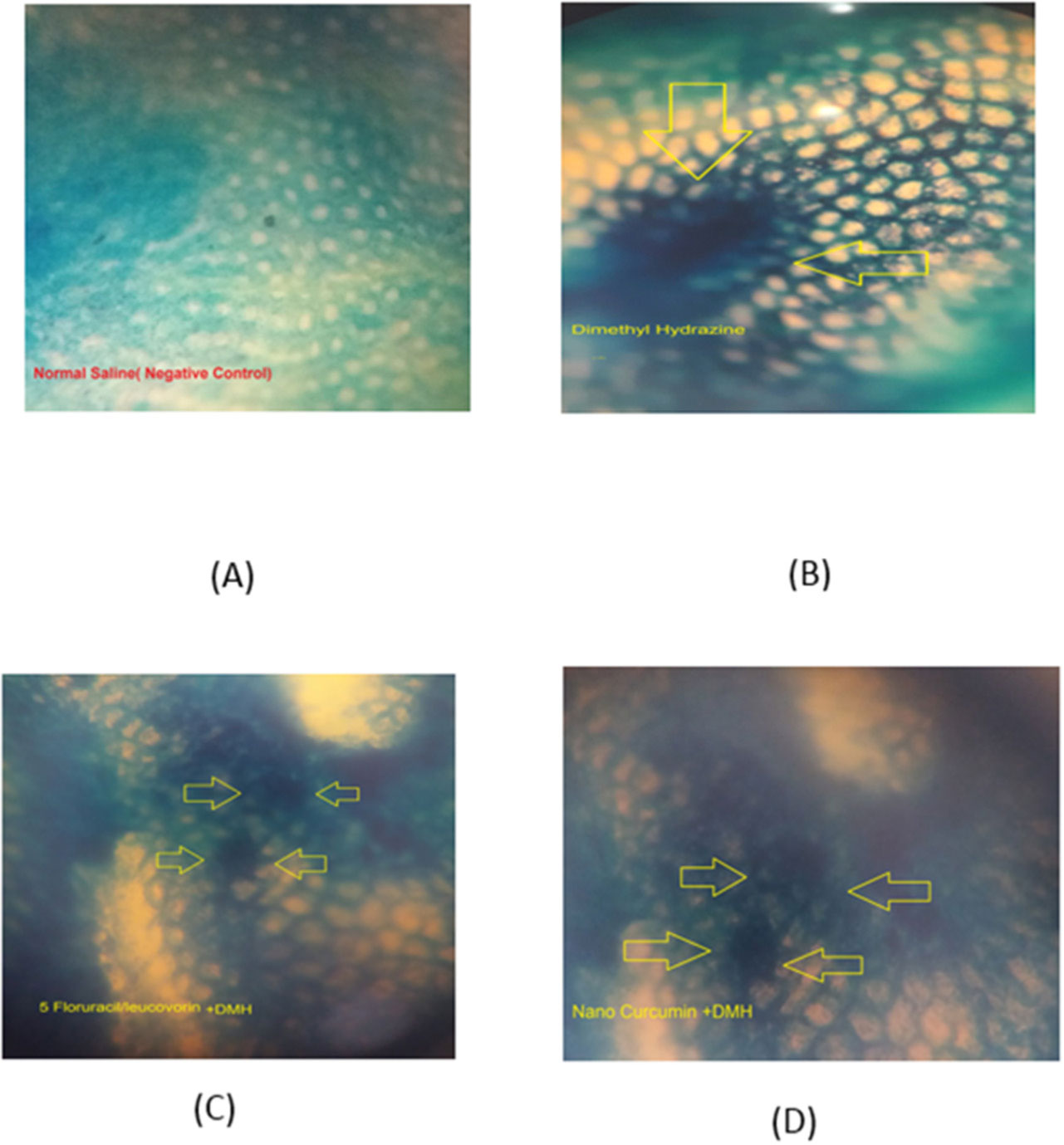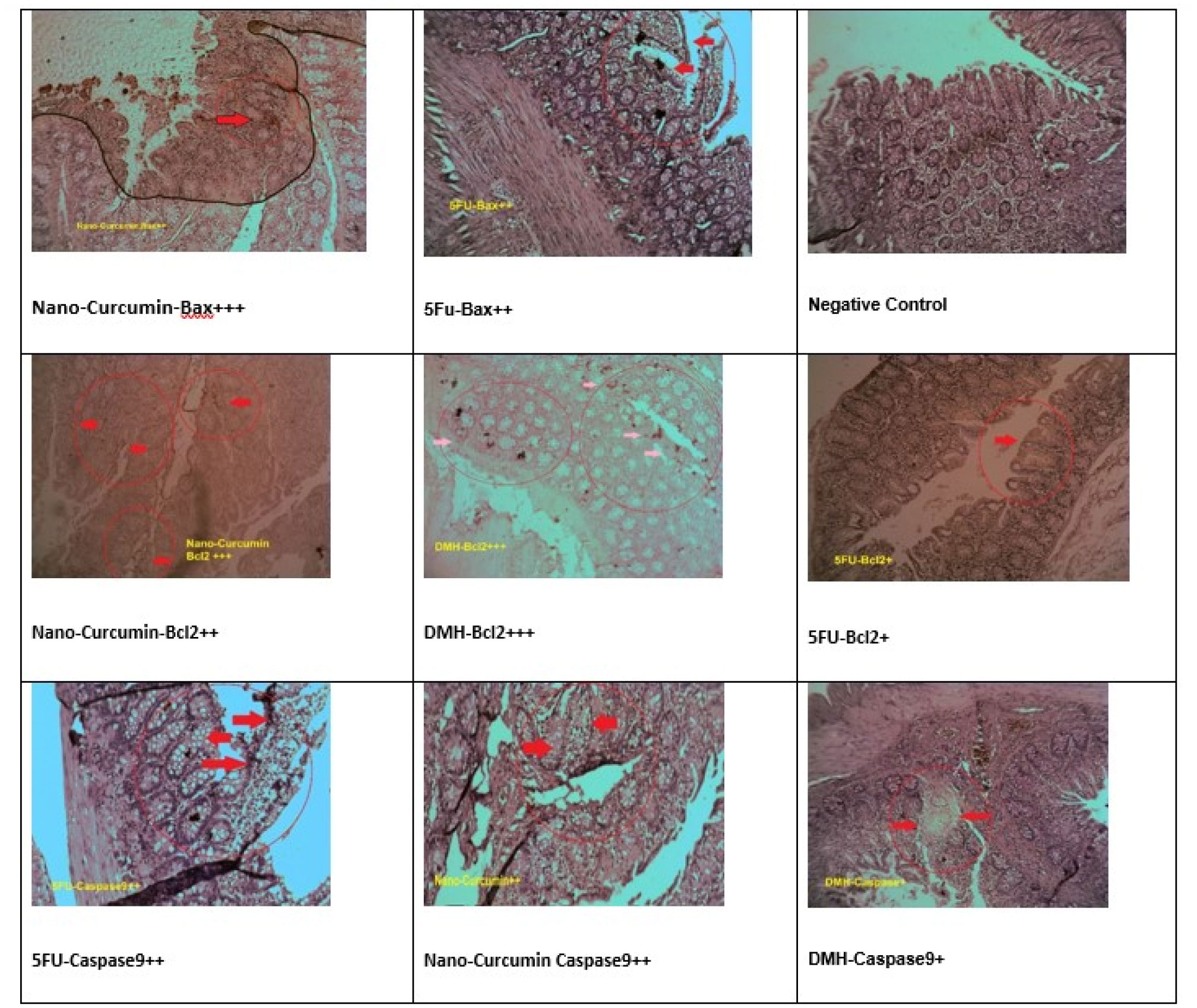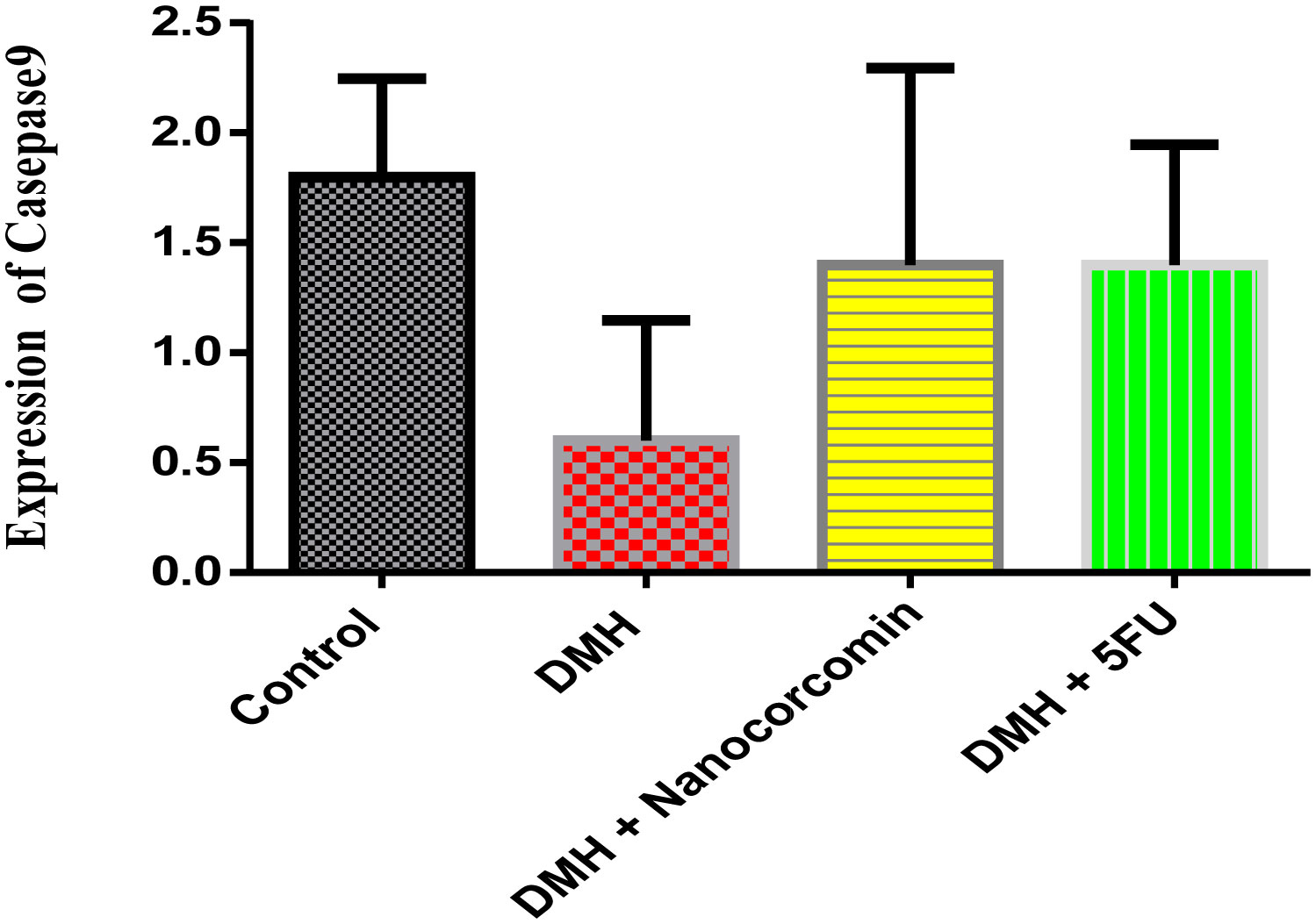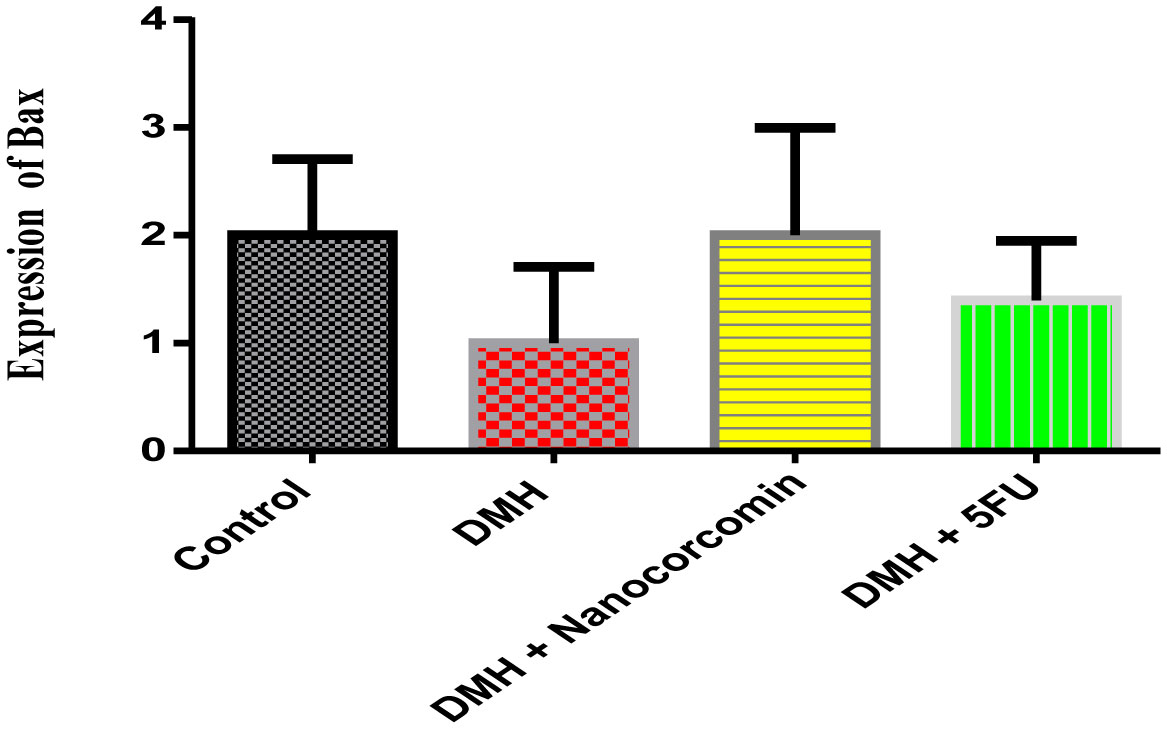Objective
Curcumin, a natural polyphenol that has anti-oxidative, anti-inflammatory and anti-cancer properties. Therapeutic potential of curcumin is substantially limited by the rather low water solubility, rapid metabolism and low bioavailability. Therefore it is necessary for its' suitable carriers. In the present study, it was aimed to assess of polymeric micelles of curcumin on experimental model of colon cancer in Rat.
Method
Pathogen-free male Sprague–Dawley rats divided into 4 groups. Animals from group A, B, C received DMH intraperitoneal injection once a week at a dose of 20 mg/kg body weight in 0.9% normal saline. Group A, as DMH control. B, C received Nano-micelle curcumin and 5-FU respectively 4 weeks before first carcinogen challenge and continued until week 30 of experimentation. After 4 weeks all animals were killed and their colon removed and investigated for morphological and immunohistochemistry studies of apoptosis and expression of Bcl2, BAX and Caspase9.
Results
It was observed significant morphological changes in Nano-curcumin groups compared with DMH group but for expression of apoptotic factors, although decrease in Bcl2 expression and increase in BAX and caspase9 observed in Nano-micelle group but these changes were not significant compared with DMH group (P > 0.05).
Conclusion
Results of this study indicate that Nano-micelle of curcumin has some preventive effect in experimental model of colon cancer in vivo but has not induced complete apoptotic effect and more studies that are complete are needed.
1.
Introduction
Colorectal cancer is the second most common cause of cancer death in the world [1]. In recent years, many progress has accrued in diagnosis and treatment of this malignancy and new therapeutics have been discovered as 5-Fluorouracil-leucovorin (thymidylate synthase inhibitor), Irinothecan (topoisomerase inhibitor), Oxaliplatin (DNA replication Inhibitor), Bevacizumab (anti-angiogenic), and Cetoximab (monoclonal antibodies targeting the EGFR) [1]. However, these therapeutics were not effective completely and with considerable side effects [1].
Curcumin, a phenolic compound extracted from rhizome of the Curcuma longa linn (Zingi-beraceae), which known as an anti-cancer chemical due to its special properties, including anti-inflammatory [1], antioxidant [1], and anti-angiogenic [1]. In vivo treatments with this chemical could have prevented polyp formation and induced apoptosis in colon cancer tissues [1].Signaling pathways suggested for its' anti-carcinogenic properties, include inhibition of nitric oxide synthase, activation of tyrosine kinase receptors and protein kinase C (PKC) pathway, change of the transcriptional factors c-jun/AP-1 and p53 and inhibition of arachidonic acid metabolism, lipoxygenase and cycloxygenase activity also have been demonstrated [1]. Also curcumin has had strong inhibitory effect in oral cancer and non-small cell lung cancer [1].
Also anti-inflammatory of curcumin base compounds has been shown in some studies, as in a research, curcuminoids and oil-free aqueous extract (COFAE) of C. longa compared with that of curcuminoids and turmerones (volatile oil), The activity against inflammation was evaluated in xylene-induced ear edema, cotton pellet granuloma models in albino Swiss mice and albino Wistar rats, respectively. The results showed that COFAE of C. Longa decreased inflammation in both models against acute and chronic inflammation and the effects were comparable to those of curcuminoids and turmerones [2].
Curcumin is a water-insoluble drug so it can carry out by polymeric micelles as transmitters, which enhances its' efficiency by targeting special cells or organs and fewer chemicals accumulate in tissues which are normal and with low toxicity and therefore higher doses of the drug can be administered [3],[4]. According to this point of view, Liu et al. [3] provided curcumin-loaded biodegradable self-assembled polymeric micelles with method of solid dispersion and improved the poor water solubility of this drug.
In a study, design and development of novel hyaluronate-modified nanoparticles for combo-delivery of curcumin and alendronate have been made in which curcumin (CUR) in the form of polymeric nanoparticles with optimized therapeutic efficacy, prepared ALN/CUR nanoparticles (NPs) were decorated with hyaluronic acid (HA) which is a well-documented biomacromolecule having exceptional bone regenerating potential [5].
Concerning these backgrounds, this study has aimed to assay in vivo administration of nano-micelle curcumin on di-methyl-hydrazine (DMH) carcinogenicity in rat model of colon-cancer.
2.
Material and methods
2.1. Chemicals
5Flurouracil-Lecuvorin, Di-methyl-hydrazine (DMH), Diaminobenzidine (DAB), were purchased from sigma Chemical Co. (Sigma Aldrich, Germany). Citrate buffer, Phospahate buffer saline (PBS). curcumin nano-micelle was prepared from Dr. Jafari Co, Mashhad University of Medical Sciences (Mashhad, Iran). Primary antibodies (BAX, Bcl2, Caspase9), normal goat serum, secondary antibody (donkey anti-goat HRP) purchased from Santa-Cruz company, USA. All other reagents and biochemicals, were obtained from Sigma Chemicals Co. (Germany).
2.2. Animals
Pathogen-free male Sprague–Dawley rats were provided at 6 weeks of age from lab animal collection center, Mazandaran university of medical sciences, Sari, Iran. The animals maintained at 25 ± 1 °C and 55 ± 15% relative humidity. A semi-purified basal diet and demineralized drinking water were supplied to the animals ad libitum. All procedures were under financial support and supervision of deputy of research of Mazandarn university of medical sciences, Sari, Iran, with project and ethical code of 2824.
2.3. Experimental design
Animals were divided into 4 groups, which group A, B, C received DMH intraperitoneal injection once a week at a dose of 20 mg/kg body weight in 0.9% normal saline. Group A served as DMH control. Animals of group B, C were treated with Nano-micelle curcumin and 5-FU respectively in addition to weekly i.p. injection of DMH, starting 4 weeks before first carcinogen challenge and continued till week 30 of experimentation. Nano-micelle curcumin has been treated at dose (8 mg/kg, IP) and 5Florouracil (5FU) + leucovorin (100, 50 mg/kg IP), once a day. Group D, as negative control received only weekly i.p injection of normal saline vehicle instead of weekly DMH injection. All the treatments were finished at week 30 [6].
2.4. Morphological study
At the end of the 30 weeks all animals were killed by cervical dislocation. Their colons were removed and washed with phosphate buffered saline and flushed. Then colons tissues were cut longitudinally and fixed flat between filter paper, in morphological study both proximal and distal parts have been assayed, this was addressed in the text. Then tissues were stained with methylene blue (0.20~ in buffered saline or buffered formalin for 30–60 min so the crypt outlines could be observed. For observing and counting the crypts, colons were placed on microscopic slides with the mucosal side up. Using ×4 or ×10 objectives, the crypts were assayed at 40 or 100× magnification for aberrant morphology.
2.5. Patholgical and immunohistochemical study
After macroscopic assay a part of tissue at crypts area were cut and embedded in formalin 4% for preparing paraffin blocks and immunohistochemistry slides. In pathological and immunohistochemically study, both proximal and distal parts have been assayed.
Tissue sections (3 µm) from paraffin blocks were prepared and for immunohistochemistry study, first deparaffinised in xylol and hydrated with embedding in decreasing alcohol degree. Then for antigen retrieval, the sections were incubated with citrate buffer (10 mM, pH 6.0), heated twice in microwave at 750 V ate for 5 min. and after cool recycling period, the sections washed three times in TBS (tween buffer saline) and incubated with normal goat IgG (10%) for 20 min. To block endogenous peroxidase activity and non-specific proteins, the sections were treated with 0.05% hydrogen peroxide and BSA 10% for 15 min subsequently. Non-specific antigen binding was blocked by incubation of sections in blocking buffer (TBS containing 10% goat serum, and 0.1% Triton X-100) for 20 min at 37 °C. Then the sections were incubated 24 h at 4 °C in humidified chambers with the specific immunohistochemical primary antibody (anti-BAX, anti-Bcl2, Anti-Caspase9, 1:250) diluted in TBS containing 0.1% Triton X-100. Then after washing the sections with TBS, they were incubated with the secondary antibody (Donkey anti goat IgG-HRP Conjugated) for 2h at 37 °C. Then for immunodetection, the sections were incubated with the immunodetection solution (DAB+H2O2 0.05%) for 10 min, and washed with tap water, and counterstained with haematoxylin. To exclude non-specific staining, parallel sections processed as above but specific primary antibodies were not used. Finally, the sections were viewed with a light microscope at 100 and 400 magnificence. Assessment of immunoreactivity level was performed using a semi-quantitative method with microscopy study of slides and 3 grades (1+, 2+, 3+) were defined for immunoreactivity concerning the strength and width of distribution of precipitated dyes in nuclear and cytoplasm of the cells.
2.6. Statistical analysis
Correlation of immunoreactivity and expression of apoptotic proteins and comparison between groups have been analyzed by mean-Whitney non-parametrical statistical test.
2.7. Statement of ethics
Authors declare that the study protocol was approved and conroled by the ethics research committee on human and animals of deputy of research of Mazandaran University of Medical Sciences, Sari Iran with ethics number: 2824.
3.
Results
3.1. Macroscopic findings
As it has shown in Figure 1, in colon of rat which received dimethyl hydrazine as carcinogen the extent of methylene blue dye has been adsorbed at area of crypts of rat colon which the extent and area of adsorption in DMH control rat has been increased compared with negative control which this area of adsorption in nano-micelle curcumin group and 5FU/leuc have been diminished clearly.
3.2. Microscopic findings
As it has shown in Figure 2, expression of apoptotic proteins of BAX and caspase9 in cancer tissues treated with 5FU and Nano-curcumin have been observed clearly and expression of anti-apoptotic proteins, Bcl2 has been diminished in 5FU and Nano-curcumin group (Graph 1–3).
4.
Discussion
Results of this study which assayed the effect of Nano-micelle of curcumin on experimental colon cancer in rat in comparison with 5FU, have shown that in macroscopy assay, preventive effects have been observed by 5FU and Nano-micelle of curcumin but in microscopic schedules and immunohistochemistry study, although Nano-curcumin increased apoptotic proteins expresions, as BAX and Caspase9 and decreased anti-apoptotic protein Bcl2, but these effects although was significant for 5FU/leuc but was not significant for nano-micelle in compared with DMH group, anyway according to caspase expression by nano-micelle, the P value was low 0.12 which was close to 0.05.
The results of this research accompanying with previous studies of Nano-micelle curcumin in various cancers; especially that Nano-micelle curcumin has less toxic effect on normal cells comparing with curcumin and its penetration across cell membrane inside cells is better [4]–[7]. Also incubation of normal lymphocyte, normal skin human and rat fibroblast with 50 mM of Nano-curcumin for 24 hr. has not any cytotoxic effect on proliferation [6]. The high anti-oxidant effect of curcumin can explain its protective effect against normal cells and also COX-2 and NO synthase, suggested as targets for curcumin [7],[8]. Also, per-oxidant properties with inducing mitogen-activated protein kinase (p38-MAPK) and phosphorylation of (JNKs)c-Jun N-terminal kinases can predict its' apoptosis effect in cancer cells [9].
Physico-chemical specialties of Nano-micelle curcumin can suggest it as an important phyto-chemical in chemotherapy of some kind of cancers because of its better transmission through biological membranes than curcumin alone [10].
Fang XB et al in 2016, observed that F68-Cis-Cur micelles was more toxic against A2780 and SMMC 7721 cancer cells than pure curcumin and diminished mitochondria's potential and induced much more cellular apoptosis [11]. Also this micellar formulation in caveolae excited endocytosis as energy dependent and increased cellular absorption of curcumin by the cancer cells [11]. In other study in 2016, it has shown that acetal-containing micelles of curcumin has PH dependent releasing effects in HepG2 (liver cancer) cells and less IC50 than curcumin [12].
In a study by by Maling Gou and colleagues (2010) for identifying anti-cancer activity of Cur/MPEG-PCL micelle for C-26 colon carcinoma, it has shown both curcumin and Cur/MPEG-PCL micelle killed colon cancer cells significantly in a dose dependent manner [13] and IC50 for curcumin was 3.95 µg/ml and for Cur/MPEG-PCL micelle, 5.78 [13].
In 2013, Mahmoud Khaniki and his co-workers in a research for investigating of anti-proliferative and anti-cancer effect of nano-curcumin in colon cancer animal model in rat, it has shown that by use of cucumin-nano carriers, the efficacy of drug in prevention of colon cancer in rat would be increased [14],[15].
Our study was in parallel with some studies especially Khaniki and Mailing Gou who have shown the high properties of Nano-micelle of curcumin in cancer cytotoxicity, and morphologic macroscopic changes have been observed in Nano-micelle curcumin group compared with DMH in microscopic immunohistochemistry assay, although Bcl2 expression decrease and BAX and Caspase expression increasing have been seen but this changes were not significant (P > 0.05). So apoptosis changes cannot be considered significantly.
5.
Conclusion
Nano-micelle curcumin can be a good drug delivery system for cancer chemotherapy regime especially colon cancer especially with low cytotoxic effect on normal cells and with better cell permeability and apoptotic effect on cancer cells; but complementary studies especially at in vivo models and clinical trials are necessary.










 DownLoad:
DownLoad:







